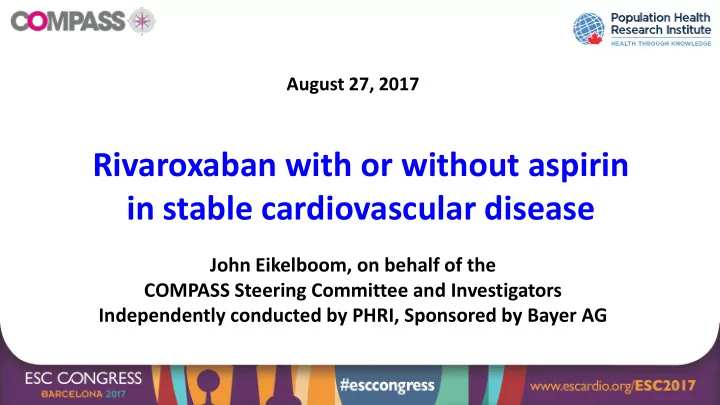

August 27, 2017 Rivaroxaban with or without aspirin in stable cardiovascular disease John Eikelboom, on behalf of the COMPASS Steering Committee and Investigators Independently conducted by PHRI, Sponsored by Bayer AG 1
2
Background • CV disease affects 4% of world population (300 million persons) and causes 18 million deaths each year • Aspirin is widely used for secondary prevention but is only modestly effective • Warfarin trial results demonstrate the potential of anticoagulation to provide benefit • Rivaroxaban reduced mortality post acute coronary syndrome (ATLAS ACS-2 TIMI 51). 3
COMPASS design Stable cardiovascular disease (CAD or PAD) Rivaroxaban 2.5 mg bid + aspirin 100 mg od Rivaroxaban 5 mg bid Expected follow up R 3-4 years Run-in Aspirin 100 mg od (aspirin) 2,200 with a primary outcome event (CV death, stroke or myocardial infarction) 602 centres, 33 countries 4
Primary: CV death, stroke, MI R + A R A Rivaroxaban + aspirin Rivaroxaban N=9,152 N=9,117 N=9,126 vs. aspirin vs. aspirin Outcome N N N HR HR p p (%) (%) (%) (95% CI) (95% CI) CV death, 379 448 496 0.76 0.90 (0.66-0.86) <0.0001 (0.79-1.03) 0.12 stroke, MI (4.1%) (4.9%) (5.4%) 5
Major bleeding R + A R A Rivaroxaban + Aspirin Rivaroxaban N=9,152 N=9,117 N=9,126 vs. Aspirin vs. Aspirin Outcome N N N HR HR P P (%) (%) (%) (95% CI) (95% CI) Major 288 255 170 1.70 1.51 (1.40-2.05) <0.0001 (1.25-1.84) <0.0001 bleeding (3.1%) (2.8%) (1.9%) 6
Net clinical benefit R + A A Rivaroxaban + Aspirin N=9,152 N=9,126 vs. Aspirin Outcome N N HR P (%) (%) (95% CI) Net clinical benefit 431 534 0.80 (Primary + Severe 0.0005 (4.7%) (5.9%) (0.70-0.91) bleeding events) 7
Conclusion Rivaroxaban 2.5 mg bid plus aspirin 100 mg od versus aspirin 100 mg od: • Reduces CV death, stroke, MI • Increases major bleeding without a significant increase in fatal, intracranial or critical organ bleeding • Provides a net clinical benefit No significant benefit of rivaroxaban 5 mg bid versus aspirin 100 mg od 8
Recommend
More recommend